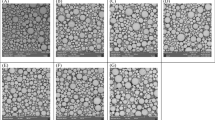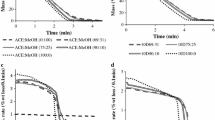Abstract
The objective of this study was to investigate the influence of processing parameters on the morphology, porosity, and crystallinity of polymeric polyethylene glycol (PEG) microparticles by spray freezing into liquid (SFL), a new particle engineering technology. Processing parameters investigated were the viscosity and flow rate of the polymer solution, nozzle diameter, spray time, pressure, temperature, and flow rate of the cryogenic liquid. By varying the processing parameters and feed composition, atomization and heat transfer mechanisms were modified resulting in particles of different size distribution, shape, morphology, density, porosity, and crystallinity. Median particle diameter (M50) varied from 25 μm to 600 μm. Particle shape was spherical or elongated with highly irregular surfaces. Granule density was between 0.5 and 1.5 g/mL. In addition to producing particles of pure polymer, drug particles were encapsulted in polymeric microparticles. The encapsulation efficiency of albuterol sulfate was 96.0% with a drug loading of 2.4%, indicating that SFL is useful for producing polymeric microparticles for drug delivery applications. It was determined that the physicochemical characteristics of model polymeric microparticles composed of PEG could be modified for use as a drug delivery carrier.
Similar content being viewed by others
References
Rogers TL, Johnston KP, Williams RO III. A comprehensive review solution based particle formation of pharmaceutical powders by super critical or compressed fluid carbon dioxide and cryogenic spray-freezing technologies. Drug Dev Ind Pharm. 2001;27(10):1003–1016.
Gombotz WR, Healy MS, Brown LR, Aner HE. Enzytech, Inc. Process for producing small particles of biologically active molecules. US5 019 400. May 28, 1991.
Gusman MI, Johnson SM, inventors; SRI International Cryochemical method of preparing ultrafine particles of highpurity superconducting oxides. US patent 4 975 415. December 4, 1990.
Webb SD, Golledge SL, Cleland JL, Carpenter JF, Randolph TW. Surface adsorption of recombinant human interferon-gamma in lyophilized and spray-lyophilized formulations. J Pharm Sci. 2002;91(6):1474–1487.
Heller MC, Carpenter JF, Randolph TW. Protein formulation and lyophilization cycle design: prevention of damage due to freeze-concentration induced phase separation. Biotechnol Bioeng. 1999;63(2):166–174.
Costantino HR, Firouzabadian L, Hogeland K, et al. Protein spray-freeze drying: effect of atomization conditions on particle size and stability. Pharm Res. 2000;17(11):1374–1383.
Sonner C, Maa Y-F, Lee G. Spray-freezing-drying for protein powder preparation: particle characterization and a case study with trypsinogen stability. J Pharm Sci. 2002;91(10):2122–2139.
Maa Y-F, Nguyen P-A, Sweeney T, Shire SJ, Hsu CC. Protein inhalation powders: spray drying vs spray freeze drying. Pharm Res. 1999;16(2):249–254.
Yu Z, Rogers T, Hu J, Johnston KP, Williams RO III. Preparation and characterization of microparticles containing peptide produced by a novel process: spray freezing into liquid. Euro J Pharm Biopharm. 2002;54(2):221–228.
Rogers TL, Nelsen AC, Hu J, et al. A novel particle engineering technology to enhance dissolution of poorly water soluble drugs: spray-freezing into liquid. Euro J Pharm Biopharm. 2002;54(3):271–280.
Rogers TL, Hu J, Yu Z, Johnston KP, Williams RO III. A novel particle engineering technology: spray-freezing into liquid. Int J Pharm. 2002;42:3–100.
Hu J, Rogers T, Brown J, Young T, Johnston KP, Williams RO III. Improvement of dissolutions rates of poorly water soluble APIs using the novel spray freezing into liquid technology. Pharm Res. 2002;19(9):1278–1284.
Lefebvre AH. Atomization and Sprays. In: Chigier N, ed. combustion: An International Series. New York, NY: Hemisphere Publishing Corp; 1989:3,79–103.
Hinze, JO. Fundamentals of the hydrodynamic mechanism of splitting in dispersion processes. AIChE J. 1955;1:289–295.
Mumenthaler M, Leuenberger H. Atmospheric spray-freeze drying: a suitable alternative in freeze-drying technology. Int J Pharm. 1991;72:97–110.
Author information
Authors and Affiliations
Corresponding author
Rights and permissions
About this article
Cite this article
Barron, M.K., Young, T.J., Johnston, K.P. et al. Investigation of processing parameters of spray freezing into liquid to prepare polyethylene glycol polymeric particles for drug delivery. AAPS PharmSciTech 4, 12 (2003). https://doi.org/10.1208/pt040212
Received:
Accepted:
DOI: https://doi.org/10.1208/pt040212




